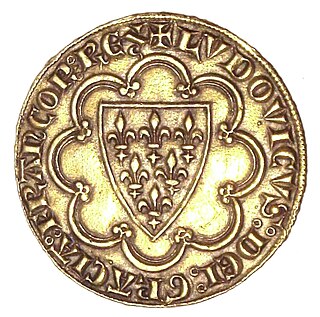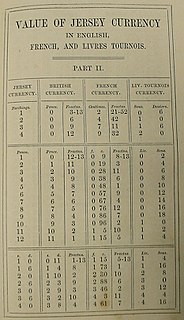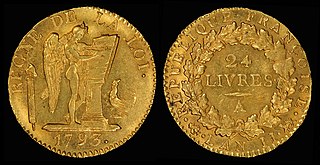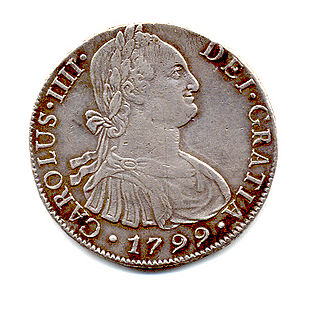
The solidus, nomisma, or bezant was originally a relatively pure gold coin issued in the Late Roman Empire. Under Constantine, who introduced it on a wide scale, it had a weight of about 4.5 grams. It was largely replaced in Western Europe by Pepin the Short's currency reform, which introduced the silver-based pound/shilling/penny system, under which the shilling functioned as a unit of account equivalent to 12 pence, eventually developing into the French sou. In Eastern Europe, the nomisma was gradually debased by the Byzantine emperors until it was abolished by Alexius I in 1092, who replaced it with the hyperpyron, which also came to be known as a "bezant". The Byzantine solidus also inspired the originally slightly less pure Arab dinar.
The livre tournois, French for the "Tours pound", was:

The pound is the currency of Guernsey. Since 1921, Guernsey has been in currency union with the United Kingdom and the Guernsey pound is not a separate currency but is a local issue of banknotes and coins denominated in pound sterling, in a similar way to the banknotes issued in Scotland, England and Northern Ireland. It can be exchanged at par with other sterling coinage and notes.

The term écu or crown may refer to one of several French coins. The first écu was a gold coin minted during the reign of Louis IX of France, in 1266. Écu means shield, and the coin was so called because its design included the coat of arms of France. The word is related to scudo and escudo. The value of the écu varied considerably over time, and silver coins were also introduced.
The livre was the currency of Haiti until 1813. The Haitian livre was a French colonial currency, distinguished by the use, in part, of Spanish coins. It was equal to the French livre and was subdivided into 20 sous, each of 12 deniers. The escalin of 15 sous was also used as a denomination, since it was equal to the Spanish colonial real. Coins specifically for use in Haiti were issued between 1802 and 1809, along with various overstamped coins.
The daler was the currency of the Danish West Indies between 1849 and 1917, and of the United States Virgin Islands between 1917 and 1934.
The livre was the currency of New France, the French colony in modern-day Canada. It was subdivided into 20 sols, each of 12 deniers. The New France livre was a French colonial currency, distinguished by the use of paper money.
The history of currency in the British colony of Dominica closely follows that of the British Eastern Caribbean territories in general. Even though Queen Anne's proclamation of 1704 brought the gold standard to the West Indies, silver pieces of eight continued to form a major portion of the circulating currency right into the latter half of the nineteenth century.
The history of currency in the British colony of Grenada closely follows that of the British Eastern Caribbean territories in general. Even though Queen Anne's proclamation of 1704 brought the gold standard to the West Indies, silver pieces of eight continued to form a major portion of the circulating currency right into the latter half of the nineteenth century.
The history of currency in the British colony of St. Kitts closely follows that of the British Eastern Caribbean territories in general. Even though Queen Anne's proclamation of 1704 brought the gold standard to the West Indies, silver pieces of eight continued to form a major portion of the circulating currency right into the latter half of the nineteenth century.
The dollar was the currency of Nevis until 1830. The currency consisted of counterstamped Spanish and French colonial coins. The dollar was subdivided into 72 black dogs, each of 1½ pence. Around 1801, coins were issued for 1, 4, 6, 7 and 9 black dogs with the word "Nevis" and the denomination stamped on them. The 1 black dog coins were countermarked on French Guianan 2 sous, whilst the 9 black dogs were made from Spanish colonial 1 real coins. In 1830, sterling was established as the official currency of the island.
The livre was the currency of Saint Lucia until 1814. The Saint Lucia livre was a French colonial currency, distinguished by the use of various cut Spanish and Spanish colonial coins. The livre was subdivided into 20 sous, each of 12 deniers. The escalin was worth 15 sous, with the stampee worth 3 sous 9 denier. Until 1813, 12 escalins were equal to 8 reales, after which 15 escalins equaled 8 reales. In 1851, sterling was introduced for circulation.
The history of currency in the British colony of Saint Vincent closely follows that of the British Eastern Caribbean territories in general. As such, it should not be considered in isolation. In order to get a broad overview of currency in the region, see the article British West Indies dollar.
The dollar was the currency of Trinidad until 1814. The currency comprised various cut Spanish dollars and other Spanish colonial coins. Before 1811, the dollar was worth 8 shillings, each of 12 pence. After 1811, it was worth 9 shillings. In 1814, sterling was established as the official currency of the island. Since 1905, dollars have once more circulated on Trinidad, first the Trinidad and Tobago dollar, then the British West Indies dollar, before the Trinidad and Tobago dollar was reintroduced.
The dollar was the currency of Tobago until 1814. The currency comprised various cut Spanish dollars and countermarked French colonial coins. The dollar was subdivided into 11 bits, each of nine pence. In 1814, sterling was established as the official currency of the island. Since 1905, dollars have once more circulated on Tobago, first the Trinidad and Tobago dollar, than the British West Indies dollar, before the Trinidad and Tobago dollar was reintroduced.

The franc was the currency of Guadeloupe until 2002. It was subdivided into 100 centimes.

The livre was currency of Jersey until 1834. It consisted entirely of French coins.
The reaal was the currency of Curaçao until 1828. It was subdivided into 6 stuiver, with 20 stuiver equal to the Dutch gulden.
The pound was the currency of Prince Edward Island until 1871. It was subdivided into 20 shillings, each of 12 pence. It was replaced by the dollar in 1871. British coins circulated, together with locally produced coins and paper money.












